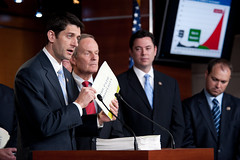With great fanfare, Rep. Paul Ryan this week introduced a budget proposal in which he has invested significant time and effort. Meant to serve as an alternative to the staggering 10-year budget introduced by Obama, Ryan’s proposal certainly looks better in comparison. Titled “The Path to Prosperity,” Ryan’s budget proposal is being widely touted as “cutting $6 trillion in spending over the next ten years.”
What is rarely noted, or little emphasized, is that this is an action relative to Obama’s proposal. Whereas Obama’s budget would have the federal government spending $46 trillion over the next decade, Ryan’s shaves that down to a meager $40 trillion. But Ryan’s proposal doesn’t balance the budget for at least another two decades, and piles on $14 trillion in new debt during that time. This supposed path to prosperity adds nearly $6 trillion to the debt in the next decade alone! (So much for “cutting $6 trillion”…)
It makes you wonder how individuals might follow this lead and pursue a similar path to prosperity. Would an individual who buys three homes instead of four, maxes out all but one of his credit cards, and spends only 90% of his retirement money and his children’s college fund be considered prosperous? Sure, it’s better than buying and spending everything in sight, but barely. The end result won’t be different, but it may be realized a little later.
This is no path to prosperity, nor is it fiscal conservatism in the slightest. It’s still kicking the fiscal can down the road, only doing so with a little less muscular exertion than the next guy. It’s as much an attempt to pursue prosperity as is a prostitute’s effort to be chaste by not servicing customers on the Sabbath. Sure, it’s “a start,” as many of Ryan’s supporters argue, but would a gradual, one-degree turn have helped the Titanic?
It’s important to note that this supposed path to prosperity also leaves untouched the Republican sacred cow: the military industrial complex. Ryan’s proposal to bring spending in line does nothing—absolutely nothing—in regards to the massive increase in “defense” spending. The Pentagon’s base budget has nearly doubled over the past ten years, and when that number is rightly augmented with all the spending done on our numerous military interventions abroad, the total amount spent on the military per year is roughly $700 billion. With roughly $6.5 trillion projected spending on the military over the next decade, one would think that an individual truly serious about this country’s fiscal health would tackle the highly-weaponized elephant in the room.
Any and all efforts to restore fiscal sanity to the federal government should be applauded. This praise should be tempered with reality, however, and properly placed into context so as not to give effusive praise for something that simply makes the current problem worse. Ryan’s goal to bring spending to pre-2008 (but post-2007) levels is absolutely better than Obama’s proposal, but fails to note that the 2007-08 levels were astronomically high to begin with! If anybody in Congress is truly serious about fixing these problems, they need to scrap 2008 as a benchmark and instead move us back towards 1908 levels.
Rep. Ryan’s budget is not a path to prosperity. It takes the current precarious situation and pushes it further down the road, adding on new debt, playing fiscal gymnastics with a few programs, and justifying its existence by saying “hey, it could have been worse…” America needs surgery and possible amputation to remedy its spreading, gangrenous infection; applying ointment and a band-aid simply will not help in the long run.
The real solution is a bitter pill to swallow, and being thus unpalatable, few are willing to comply. We need entire departments abolished outright, military adventurism terminated forthwith, social welfare programs quickly dismantled, and an across-the-board reduction in the size and scope of government, with a focus on constitutional justification for everything government does. It’ll hurt, the effects will take some time to recover from, and few will be happy about it. But if we’re really serious about fixing the problem and putting America on a path to prosperity, it’s the only way.
Anything short of that is political posturing and fiscal fantasy. Placebos, like this “Plan to Prosperity,” don’t solve anything.
***************
Continue reading at the original source →




